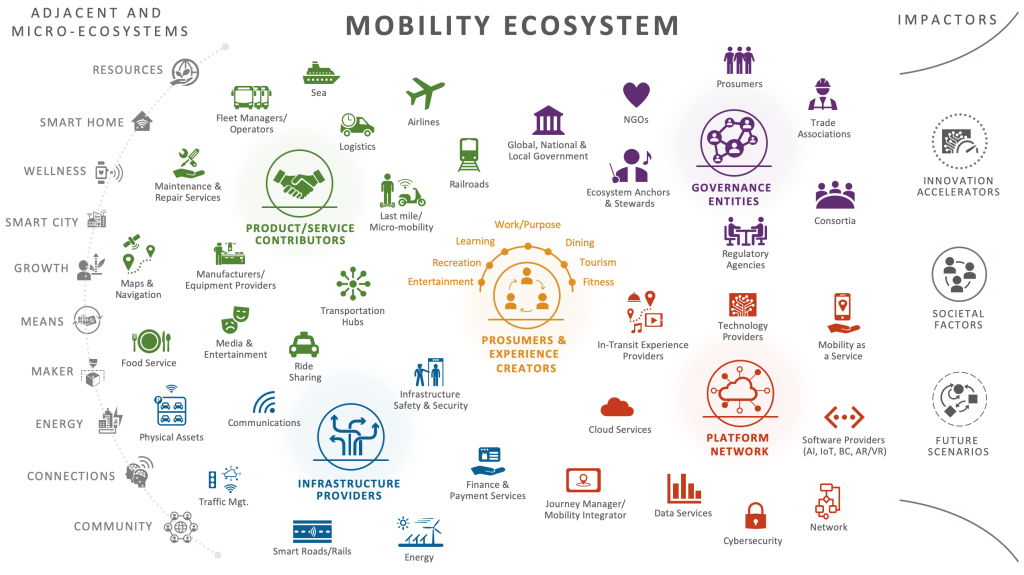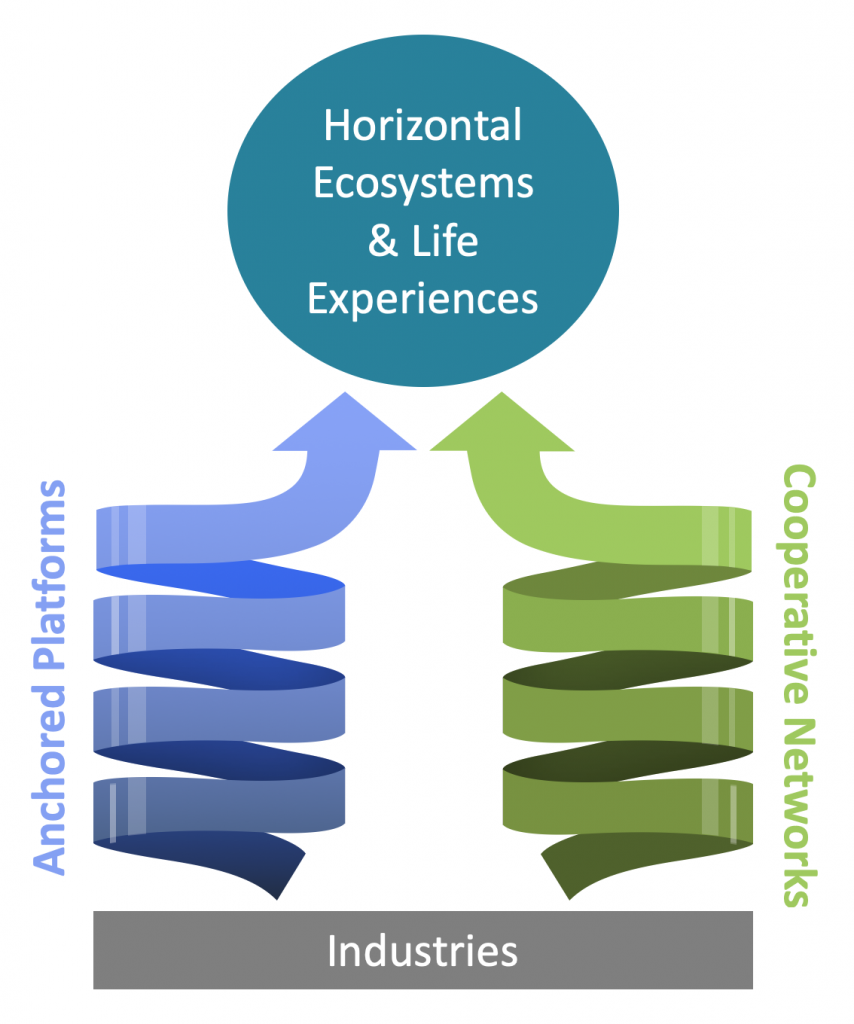I’d like to acknowledge Rose Castellon-Rodriguez, Frank Diana, Bill Quinn, and Danielle Stanko for their contributions to this article.
Since the advent of the internet, the combinatorial effect of innovation in science and digital technologies has rapidly driven the world toward a platform economy where software, apps and APIs enable every human activity and radically change how people interact and create value. Companies like Google, Microsoft, Facebook, Amazon, Apple, Alibaba and Tencent, which represent seven of the top ten valued companies by market capitalization, are leading this transformation and have created an imperative for all companies: develop platform capabilities and adapt your strategy to survive and succeed in the platform economy.
Not surprisingly, many conversations are occurring around platform strategy. Most have centered on the need to build platforms, services, and apps that customers and suppliers integrate into their operations or upon which they innovate. Yet, we see a new conversation emerging – one that goes beyond how a company becomes a platform business. That conversation is focusing on how platform businesses collaborate to co-create ecosystems. It focuses on the potential of ecosystems to not only change the nature of competition, but to disrupt the structure of our industries and ultimately create multidimensional value across the private, public and social sectors of the economy. Mindshare around this new conversation is increasing – witnessed by the number of C-Level executives that are making it a priority.
Grounding the platform conversation in ecosystems

When we discuss platforms, we ground the conversation in the ecosystems they enable. We see four types of ecosystems emerging: enterprise, value chain, cross-industry and cross-sector. In each type, stakeholders (people, organizations, machines and even sensors) interact via a platform that enables business and/or societal outcomes. The ecosystem types differ in the common purpose by which they attract participants.
- Enterprise ecosystems, which comprise participants from a single enterprise, are focused on agility, collaboration and efficiency within that enterprise. Examples include shared services in cross-business unit processes like procure to pay, order to cash and record to report.
- Value chain ecosystems focus on the efficiency and effectiveness of processes that span entities; for example, as customers, manufacturers, suppliers and partners collaborate on the development, manufacturing and distribution of a product.
- Cross-industry ecosystems incorporate products and services from multiple participants and industries into experiences that make consumers’ lives more convenient and personalized.
- Lastly, we see cross-sector ecosystems emerging as consumers demand better collaboration across the private, public and social sectors to embed fairness, transparency, and privacy into their experiences as well as ensure accountability and social responsibility from ecosystem participants.
Advancing platform conversations by modeling ecosystems
To envision an ecosystem, we model the participants, value exchanges and explore the possible value propositions that it brings to life. Figure 2 illustrates how we model an emerging cross-sector ecosystem around mobility, for example.

Throughout the process of modeling an ecosystem, we identify participants and categorize them into five emerging ecosystem roles:
- Platform Network – is comprised of entities that provide software and services that customers and suppliers embed into their offerings, thereby collectively creating a convenient process or value chain for consumers.
- Product/Service Contributors – provide products and services which are made available via APIs to the platform network and are embedded into value chains which support consumer life experiences.
- Infrastructure Providers – provide the products and services that are common to all platform networks and ecosystems, such as physical assets, telecommunications, energy, finance & payments and other common resources.
- Prosumers & Experience Creators – are individuals or organizations who create unique experiences that appeal to interest-based communities. They embed value chains and offerings from multiple ecosystems into their experiences.
- Governance Entities – are entities who define the common purpose of the ecosystem and manage rules for membership, access, monetization and dispute resolution. This may be comprised of businesses, governments, NGOs, trade associations, prosumers, and/or the community at large.
We identify other ecosystems that are likely to interact with the modeled ecosystem to support a person’s life experience. In our example above, mobility plays a key role in most life experiences. So, a mobility ecosystem would support a number of other ecosystems like those underpinning smart homes and cities, health and wellness, leisure and manufacturing. Likewise, a mobility ecosystem would consume products and services from such foundational ecosystems as those formed around energy, communications and financial services.
We also include innovation accelerators, societal factors and future scenarios that are likely to impact how an ecosystem emerges. Innovation accelerators are advances in science and technology that are likely to impact innovation within the ecosystem. Likewise, societal factors, which are behavior influencing trends from culture, environment, community, government, media, and ideology, shape the future direction of the ecosystem. Future scenarios also affect how the ecosystem may emerge. In mobility for example, autonomous and electric vehicles, the sharing economy and a logistics internet represent significant change in the future of mobility.
As we’ve modeled ecosystem possibilities, we’ve ultimately seen an appreciation for a future where platforms deliver value to a broad ecosystem of stakeholders that ultimately remove friction from markets and create convenient, personalized and socially conscious life experiences.
Governance will influence how ecosystems evolve

While platforms are intended to remove friction, as they proliferate, we foresee market fragmentation reintroducing friction. We believe the amount of friction will depend largely on how ecosystems are formed and governed. We see two governance approaches emerging: Anchored ecosystems are governed by a driver or orchestrator that is either a current major entity or an entity that emerges. This approach is highly susceptible to fragmentation as platform players compete for market leadership. We expect this approach to evolve as markets have evolved historically – that is, through business combinations and market consolidation, and may possibly culminate in the formation of platform monopolies and oligarchies. In contrast, open platform cooperatives are anchorless and co-governed by ecosystem participants with the express intent of avoiding fragmentation and protecting ecosystem participants against the formation of platform monopolies and oligarchies. In either approach, the intent is to create frictionless consumer life experiences. We anticipate this leading to a collapse of our current industry constructs and the rise of horizontal ecosystems. It’s easy to recognize this progression in the blurring of industry boundaries that manifest themselves in connected cars, smart homes, smart cities, and other emerging scenarios.
Key factors when considering platform ecosystems
Because platforms and ecosystems create frictionless experiences that allow multiple participants to simultaneously monetize offerings and/or advance their objectives, there is a great need for everyone to develop their platform capabilities, envision their ecosystem role and rehearse future scenarios. We offer the following key considerations to those embarking on a platform ecosystem journey:
- Create an ecosystem vision to guide your platform strategy and capability development – Look beyond traditional vertical/industry boundaries. A mobility ecosystem would support experiences in healthcare, leisure, tourism, smart cities and logistics. Also, consider how ecosystems can create new forms of value that go beyond removing friction. For example, a broader mobility purpose that includes reducing carbon emissions could attract more participants.
- Explore multiple ecosystem roles based on opportunity, market dynamics and positioning – Consider playing different roles in multiple ecosystems. You may adopt another’s platform, be a participant in an ecosystem, lead a platform marketplace and/or choose to be a member of a cooperative. Consider market dynamics and your market position when rehearsing scenarios and roles. An airline, for example, might adopt a digital identity platform, participate as a mobility provider in an energy ecosystem, lead an air transportation ecosystem and join a non-profit cooperative like Mobi, a cross-sector smart mobility consortium.
- Be thoughtful about governance – Because platforms can enable multi-sector ecosystems that create economic and societal outcomes, they require new and complex forms of collaboration and governance. How an ecosystem is formed, including membership access, curation, decision making, monetization opportunities and intellectual property rights, will impact the ecosystem’s ability to attract participants and proliferate
- Develop collaboration competencies while building platform capabilities – While it’s mandatory to develop platform capabilities like software development, commercializing APIs and embedding platforms into customer and supplier value chains, the ability to collaborate will become a differentiating competency as the platform economy shifts from separate API-connected platform businesses to co-governed platform networks where assets are co-created and held in common.
Conclusion
As platforms emerge and proliferate, so too will the ecosystems they enable. Conversations are evolving beyond the need to become a platform business to how to thrive in a boundaryless world of ecosystems. To succeed in this new world, every business should envision and model various types of ecosystems, consider playing multiple roles, make governance and collaboration a priority and most importantly, rehearse multiple possible scenarios as ecosystems emerge.
